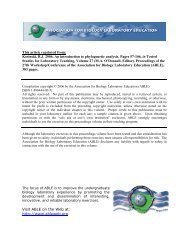A Study of Gene Linkage and Mapping Using - Association for ...
A Study of Gene Linkage and Mapping Using - Association for ...
A Study of Gene Linkage and Mapping Using - Association for ...
You also want an ePaper? Increase the reach of your titles
YUMPU automatically turns print PDFs into web optimized ePapers that Google loves.
6 Tetrad Analysis<br />
The spore color <strong>of</strong> the normal (wild type) Sordaria is black. This phenotype is due to the<br />
production <strong>of</strong> the pigment melanin <strong>and</strong> its deposition in the cell walls. Several different genes are<br />
involved in the control <strong>of</strong> the melanin biosynthetic pathway <strong>and</strong> each gene has two possible allelic<br />
<strong>for</strong>ms. The gray spore gene has two allelic <strong>for</strong>ms: the wild type allele (g + ) <strong>and</strong> a mutant allele (g).<br />
The tan spore gene also has two <strong>for</strong>ms: a wild type allele (t + ) <strong>and</strong> a mutant allele (t). Normal black<br />
spores are produced only if both wild type alleles are present at the loci <strong>of</strong> both genes. Thus, black<br />
ascospores have the genotype g + t + (remember, spores are haploid). Those with the genotype g t +<br />
are gray, while g + t ascospores are tan. Ascospores that are g t show a cumulative effect <strong>of</strong> the two<br />
mutations <strong>and</strong> are colorless.<br />
Microscopic study shows that Sordaria has seven different chromosomes (n = 7). Are the gray<br />
spore <strong>and</strong> tan spore genes located on the same or on different chromosomes? <strong>Gene</strong>s that are located<br />
on the same chromosome are called linked genes. <strong>Gene</strong>s on different chromosomes are called<br />
unlinked genes. Today you will initiate a cross between the gray ascospore mutant strain <strong>and</strong> the<br />
tan ascospore mutant strain <strong>of</strong> Sordaria fimicola. In two weeks, you will use tetrad analysis to<br />
collect data from this cross <strong>and</strong> you will apply a knowledge <strong>of</strong> meiosis <strong>and</strong> Mendel’s two principles<br />
<strong>of</strong> inheritance to determine if the tan spore <strong>and</strong> gray spore genes are linked or unlinked <strong>and</strong> to map<br />
the location <strong>of</strong> each gene on its chromosome.<br />
Setting Up the Gray Spore × Tan Spore Cross<br />
1. Each pair <strong>of</strong> students should obtain two petri dishes containing cornmeal-glucose agar<br />
supplemented with 0.1% yeast extract. In addition, the class will be sharing several stock<br />
culture plates <strong>of</strong> the two mutants.<br />
2. Disinfect the work surface where you will be setting up the genetic crosses by thoroughly<br />
wiping the bench top with an ethanol saturated paper towel.<br />
3. With a marking pen, divide the bottoms <strong>of</strong> your petri dishes into fourths. Label each quadrant<br />
with a g + t or g t + as shown in Figure 1.2.<br />
Figure 1.2. Appearance <strong>of</strong> petri dish bottom <strong>for</strong> receiving inocula to make the gray spore (g t + ) ×<br />
tan spore (g + t) cross.<br />
4. Flame an inoculating loop with your alcohol burner. Lift the lid <strong>of</strong> one <strong>of</strong> the stock culture<br />
plates slightly <strong>and</strong> cool the inoculating loop by touching it to the lid’s sterile inner surface. Use<br />
the loop to cut a small piece <strong>of</strong> agar (about 3 mm square) containing abundant mycelial growth.<br />
5. Quickly transfer this inoculum to the center <strong>of</strong> the appropriate quadrant <strong>of</strong> one <strong>of</strong> your petri<br />
plates. Lift the lid <strong>of</strong> this plate just enough to allow insertion <strong>of</strong> the loop.
















